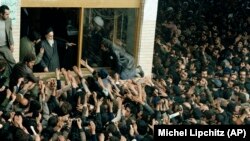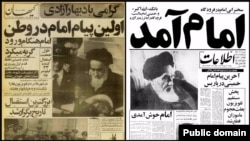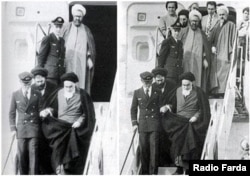On February 1, 1979 Ayatollah Rouhollah Khomeini returned to Iran after 15 years in exile as the leader of a revolution that had sent Iran's last monarch, Shah Mohammad Reza Pahlavi to exile.
An iconic photograph of Khomeini, coming down the stairs of the aircraft that brought him to Iran has changed over time, doctored to eliminate images of those who accompanied him but were later alienated in a way that he or his staunch supporters wouldn't want to see them next to the founder of a changing Islamic Republic.
A Radio Farda documentary hosted by Roya Karimi Majd, followed the fate of those who accompanied Khomeini in his final journey to Iran with some 30 of his aides and around a hundred reporters.
Those on the same plane with Khomeini, hardly slept during the long night, but if they did, they had a different dream each. Many woke up soon to find out that their dreams would fade away as Khomeini's promises about bringing about democracy soon gave way to an authoritarian clerical rule and his revolution devoured many of its children including those on the stairs as well as those behind him waiting to see Iran, some after many years.
Prominent historian and political analyst Dr. Abbas Milani told Radio Farda in the program that the combination of people around Khomeini on the plane was carefully pre-planned and was not "accidental." He refers to Khomeini's negotiations with "Americans in Paris" and "his representatives' negotiations with Americans in Tehran."
"It was exactly the combination that was planned to be on Khomeini's cabinet later," adding that "Khomeini promised to create a 'National Front' or 'Freedom Movement' government." Said Milani. These were liberal political groups that were influenced by the ideas of former Prime Minister Mohammad Mossadeq, a nationalist politician who was removed from office during a coup in 1953.
"Khomeini clearly and repeatedly promised to negotiators and the nation of Iran that clerics, including himself are not going to be in power. He said he would go to the seminary in Qom." Milani added, reminding that "The Constitution prepared in Paris for the next regime was based on the constitution of the fifth French Republic and did not contain anything about Velayat-e Faqih," or the rule of a top cleric, an ideology that brought about authoritarian clerical rule.
According to Milani, it took the clerics only a few moths to replace Prime Minister Bazargan's liberal government by the powerful cleric-dominated Revolutionary Council.
As regards Khomeini's travel companions in his journey to Tehran, Sadeq Qotbzadeh, who was sitting next to him on the plane was executed on charges of conspiring to assassinate Khomeini three years after he was appointed the head of the state Radio and TV and Foreign Minister.
Ayatollah Morteza Motahari, said to be one of the theoreticians of the Islamic revolution, and Haj Mehdi Araqi, Khomeini's pay master in Paris, were assassinated by a radical Islamist group in Tehran within weeks of the victory of the revolution in February 1979.
President Abolhassan Banisadr, was disqualified around less than a year after being elected and had to secretly fly back to exile in Paris. He was disqualified by hardliners around Khomeini, including Ali Khamenei, who was an MP at the time.
Ayatollah Hassan Lahouti Eshkevari died while in custody in 1982. Many reports say he was killed but prison officials, who link him to an outlawed opposition group, say he committed suicide.
Khomeini's own son Ahmad, is said to have been killed in 1995 in a plot led by "rouge elements" at the Intelligence Ministry, by meddling with his medication.
A few including Hassan Habibi, who served as vice-president under several Iranian presidents, and Sadeq Tabatabai, who was the spokesman for the government in 1979, died of natural causes after years of illness.
The same picture showing Khomeini and a dozen others on the staircase, was doctored skillfully so many times that its most recent versions show only the pilot ushering Khomeini to the troubled country.






